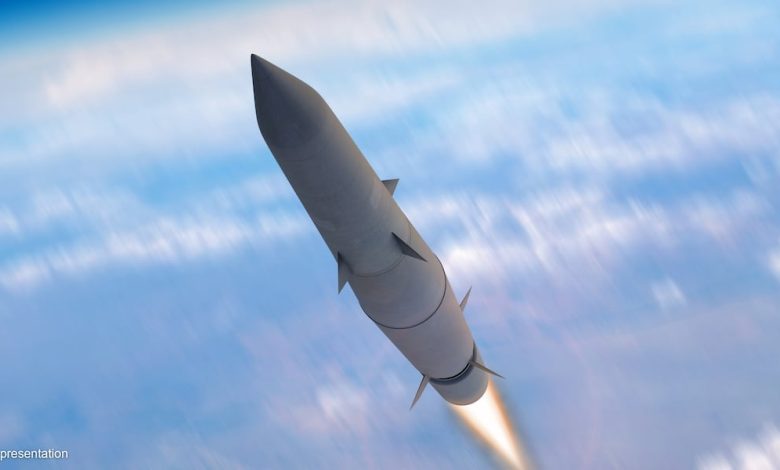Reduced funding slows MDA’s hypersonic interceptor development

The Missile Defense Agency is facing a roughly three-year delay in its plan to deliver an interceptor capable of defeating a hypersonic weapon in the glide phase of flight, according to its director.
In an attempt to mitigate the delay, the agency truncated a competitive development effort years’ early, choosing one team to go it alone to design and build the Glide Phase Interceptor. But the program’s reduced funding levels have still slowed down the program, MDA confirmed in a May 6 statement to Defense News.
“The glide phase interceptor program (delay) was due to priorities and resourcing decisions,” Lt. Gen. Heath Collins, MDA director, said in testimony before the House Armed Services Strategic Forces subcommittee on April 30.
“Last year, we were driven to make an earlier selection and a down-select years earlier than planned,” he said.
MDA chose Northrop Grumman to design the interceptor last fall, prior to even reaching a preliminary design review. Ideally, major programs remain competitive through critical design review in order to motivate competitors to deliver high levels of capability at appealing price points. Each design review phase can typically take between a year and a year and a half.
In the fiscal 2024 National Defense Authorization Act, Congress mandated MDA move more quickly by requiring the agency to reach full operational capability by the end of 2032 and provide no fewer than 12 GPIs for tests by the end of 2029.
The funding the agency has received for the program “will actually push that delivery to 2035,” Collins said.
“It’s primarily a resourcing at this point. There are some technology things that need to happen in the next three to five years, but then there is a resourcing alignment issues that could accelerate that,” he added. “We believe we could recover to 2032 with no increased level of programmatic risk across the program, but that’s about the fastest we could do today.”
In the meantime, Collins said MDA is exploring other alternatives or options that could fill a partial or residual capability from other systems.
“But as it stands today, the only hypersonic maneuvering target defense capability we have is in the fleet with the SM-6 [missile] and the Sea-Based Terminal [radar] capability,” he said.
MDA is also delayed by about 18 months in fielding its Next-Generation Interceptor that will replace the Ground-Based Interceptors making up the Ground-Based Midcourse Defense system, designed to defend the continental U.S. from intercontinental ballistic missiles that could come from Iran and North Korea.
Again, the service chose a winner over a year earlier than planned, selecting Lockheed Martin and its partner L3Harris’ Aerojet Rocketdyne in April 2024 to continue the development of NGI.
“Due to a funding decision and priorities, we did downselect to a single contractor last year, a year and a half earlier than expected,” Collins said in testimony.
The NGI will play a big role in the Trump administration’s Golden Dome missile defense shield to protect the U.S. homeland from air and missile defense threats from a wide variety of adversaries. Golden Dome would likely call for an increase of NGIs well beyond the 44 GBIs already in place, although the official plans for the architecture have yet to be revealed.
“Our No. 1 risk issue and risk going forward with either the vendors at that time was the solid rocket motor effort and development,” Collins said. “This is a new booster, a new development, and we have experienced delays and issues with that development and are expecting 18 month or more delay in the delivery of that initial capability.”
The agency said the previous schedule supported an initial operational capability for NGI no later than the fourth quarter of fiscal 2028.
MDA has “taken actions to shore up that development as well as bring in an additional source to help buy down the schedule risk of the development as we move forward,” Collins added.
The Army operates the GMD system, and the service’s Space and Missile Defense Command commander, Lt. Gen. Sean Gainey, told reporters in a May 2 briefing that any delay to capability that would address advanced threats “is obviously concerning.”
But, he added, “we’ll continue to work with Missile Defense Agency to mitigate from an upgrade of the current GBIs, an upgrade of the software as necessary to be able to fight the fight with the capability that we have right now.”
“It is still the foundation for the future of ballistic ICBM protection of the homeland and we are 100% committed and focused on that program,” Collins said.
Jen Judson is an award-winning journalist covering land warfare for Defense News. She has also worked for Politico and Inside Defense. She holds a Master of Science degree in journalism from Boston University and a Bachelor of Arts degree from Kenyon College.







